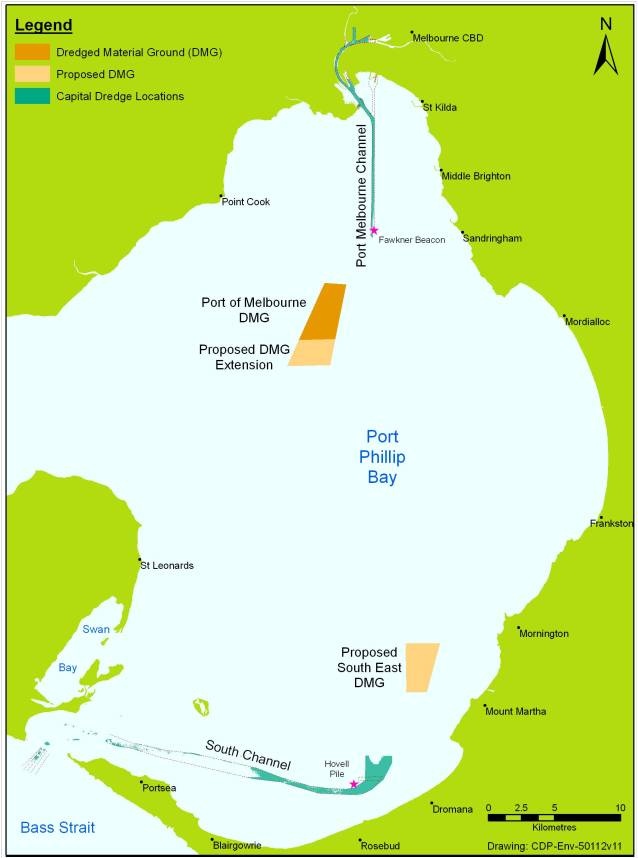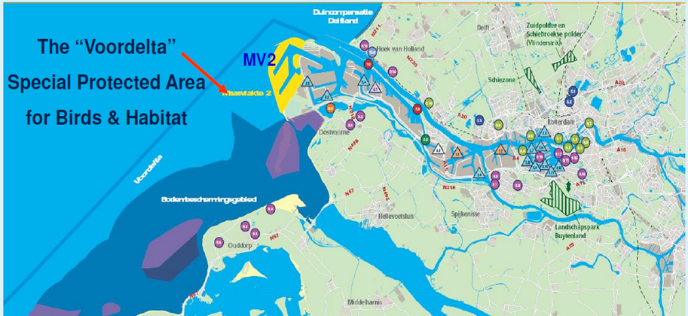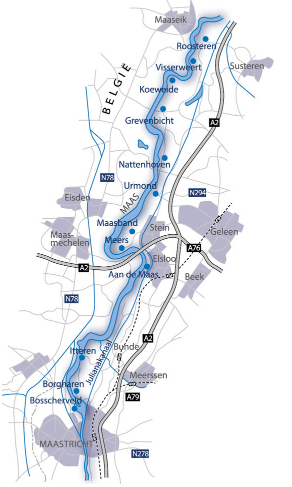Overview
The success of a Building with Nature program depends to a large extent on the ability to build organisational and contractual arrangements which support the realisation of BwN-type projects. To provide guidance in achieving such, the following questions are addressed:
- How can organisational structures, procurement and contracts facilitate BwN-type projects?
- Which specific arrangements with regard to organisation, procurement and contracts are conditional for realisation of such projects?
The contracting phase is preceded by activities such as seeking opportunities for BwN, putting it on the agenda of relevant stakeholders, building relationships and trust, and collective learning (see sections on networks and knowledge). These are all voluntary activities by separate legal entities, and the boundaries around participating groups are fuzzy. The ultimate proof of the pudding is in pro-actively organising the project environment, such that the results of all efforts can be harvested. In the realisation phase important resources such as finance and space will be committed, and so the aims, inputs and responsibilities need to be formalised. Therefore, attention should be paid to an appropriate ‘realisation framework’.
The guidance is structured as follows:
- First a general perspective on BwN related aspects of good water governance, procurement and contracts is offered. It clarifies how project tasks and responsibilities change when BwN principles are applied.
- Under ‘Guidance’ information is provided on innovative types of procurement and contracts needed to support BwN within project boundaries. It addresses the option of Public Private Partnerships and the relation with stakeholders in the project implementation stage.
- Three examples concern marine / riverine infrastructural projects: the Port Phillip Bay Channel Deepening project of the Port of Melbourne Corporation, the Maasvlakte 2 extension of the Port of Rotterdam and the Grensmaas River Refurbishing project in the Netherlands.
- ‘References’ offers a number of sources for further reading.
Good water governance
Involving stakeholders and entering a dialogue with them, as is described in the section on networks, is already a great start of a ‘good governance’ approach. In the scoping and agenda-setting phase this may not be very systematic; therefore, in the realisation phase it is helpful to use the ‘good governance building blocks‘ of the Dutch Water Governance Centre (WGC) as a checklist in order to repair potential gaps.
Good water governance is defined as governance that leads to effective, efficient and sustainable water management, to achieve the desired results in the control of water pollution, the prevention of disastrous flooding, and the effective, efficient and well-balanced dealing with periods of water shortage (Havekes et al, 2016).
The Building Blocks for good water governance (Havekes et al, 2016) have been developed to assist Dutch engineers, consultants and scientists in developing water projects abroad in an effective and legitimate way. General principles of good governance are applied and steps are proposed to include local knowledge and prevent social barriers like distrust from arising. The basic questions are in the table below. In the references list the full document can be found.
| Building Block | Questions |
| Powerful administrative organisation | Are the roles and responsibilities clear?Do we have the necessary knowledge and skills? |
| Legally embedded | Do we have the necessary tools?Is the water policy well connected with other policy fields (e.g. spatial planning)? |
| Systematic planning | Is there a clear policy and planning for the water management?Do we have sufficient and relevant information? |
| Financing | Is functioning of the financing system ensured?Is it transparency how the money is spent in water management? |
| Participatory approach | Are all the stakeholders involved in decision making for water management?Is there enough confidence to work together? |
What is good procurement for BwN?
Procurement is a process of finding and acquiring goods, services or works from an external source. Procurement comprises more than just buying stuff. With mass products or simple services such as a taxi drive, the contact between buyer and seller can be very short. A process of procurement is in place when a prolonged buyer – seller arrangement is the aim, when it concerns a service or a product that is still ‘invisible’ at the time it is bought, and when larger sums of money are at stake. The process is used to ensure the buyer receives goods, services or works at the best price-quality ratio.
Procurement can be business-to-business or business-to-government. In the case of BwN, it is practically always business-to-government. Public bodies often define processes intended to promote fair and open competition while minimising risk, such as exposure to fraud. Governments also make (sometimes mandatory) use of economic analysis methods such as cost-benefit analysis. Where risk is involved, either in the costs or the benefits, the concept of best value will often be employed.
Governments have to follow an open tender process when they outsource works and contracts. The rules, procedures and requirements for this can be traced in national legislation. The bid process typically includes prequalification or integral qualification criteria, including technical and organisational qualification for similar work and financial eligibility, expressed in terms of total turnover. Such rules that frame competition and determine who is eligible influence the line-up of private parties interested in tendering, such as consultants and contractors. Often a consortium of organisations is called for, to convince authorities that the best value can be delivered. This also leads to high entrance barriers and doesn’t stimulate the development of a BwN-market.
Reshuffled tasks and responsibilities in BwN projects
In the project implementation phase BwN becomes concrete. The definition of tasks and responsibilities in projects is of crucial importance since this defines the domain in which procurement and contracts have to be organised. Traditional procurement focuses purely on competition, which is suitable for simple and standardised projects with low uncertainty. However, BwN projects involve complexity and uncertainty. Procurement aiming for collaborative schemes, in which it is expected that relationships between project participants will be encouraged, can improve project outcomes.
So if BwN changes project settings, it is important to understand how.
- Infrastructural projects (including BwN projects) generally consist of four phases: initiation phase, planning and design phase, project construction phase, and operational and maintenance phase.
- Each of these phases comes with its own internal logic, and each involves different actors that each play their role in mobilising rules, resources and discourses. Driven by responsibilities, ambitions and motives, the roles and goals of these actors may be conflicting.
- BwN is partly still under development; it is an innovation that needs additional funding for further development, and a long term relationship between partners to enhance learning (see also the section on knowledge).The integrated multi-scale and multi-sector approach seeking to optimise on the potential of the ecosystem will raise complexity. Hence cross-sectoral and cross-disciplinary ways of working are a necessity
- Applying Building with Nature principles throughout the phases implies new relations between governments and private parties and new responsibilities and roles for knowledge workers, decision makers, stakeholders, consultants and contractors.
- This means that tasks and responsibilities are reshuffled: in decision making on the project objectives the public actors will stay responsible and accountable. Knowledge workers, consultants and contractors, however, may play significant roles in the learning process on how an integral approach can be achieved and how natural forces can be used.
- A precondition therefore is that participatory horizontal relationships between governments, stakeholders, knowledge workers, consultants and contractors be established, like BwN principles suggest.
- The close cooperation between different partners including governments towards a BwN solution may conflict with regulations regarding open competition for infrastructural projects. For a company it may be unattractive to share an innovative idea if a government will later use this to organise an open competition; and a government may be hesitant to commit itself to only one company or consortium before it is clear what the feasibility of a proposal is.
Inevitably, the question needs to be answered how to deal with procurement and contracts if a project is to be realised in an environment with reshuffled tasks and responsibilities while embracing BwN.
Guidance
This section gives guidance on the case by case application of the redefined procurement and contracting procedures. It is written for all parties that can be involved in a BwN process: a government that needs a BwN type of solution; contractors, NGO’s and research institutes aiming to develop BwN projects further and consortia or project developers who just stepped into a BwN project.
This Guidance section addresses the following topics:
- Pre-competitive arrangements
- Innovative organisation of procurement and contracts
- Organise procurement pro-actively
- Types of procurement
- The procurement process
- Effective management of procurement and implementation
- Feasibility of innovative procurement
- Public Private Partnerships
- Dealing with stakeholders in the implementation stage
Pre-competitive arrangements
Not all projects are realised through regular competitive bidding by contractors; especially in the phase of technology development, a test bed is needed in which contractors, research organisations, governments and/or land owners cooperate. Together they work on a new technology that may solve a problem in their environment, but may also help out in other locations. Because of this wider applicability, higher scale governments such as a national government or the EU may be willing to invest in it. The project will have a smaller scale and will be accompanied with a relatively large research component for monitoring and modeling. Because of novelty, the risk of failure is also present, as well as the chance that adaptive steering is necessary. Such risks can be contained with specific agreements between involved parties, for example a bandwidth within which the technical solution will be regarded as a success; the measures taken when the technology does not perform within that bandwidth; and a decision structure (a committee) that can take action in the case of unforeseen developments.
Innovative organisation of procurement and contracts
The reshuffling of tasks in BwN projects compared to traditional procurement processes call for a redesign of the setting in which project realisation takes place, such that the partners involved in a BwN-approach can rely on a relatively long term security of the arrangement. It means that both authorities and private organisations have to be willing to rethink their roles in the process, to think differently about how they can make best use of each other’s competences and resources, and to act differently in their new roles. Possibly, contractors (hired for design & construction works) will also play a more substantial role during the initiation and planning phases, or during to operation and maintenance phase (Design, Build, Finance and Maintain (DBFM)-contracts). This has implications for the enabling procurement and contract types.
In practice, two upscaling strategies to meet the qualification criteria are observed: the formation of substantial main contractor – sub-contractor consortia, in which the ex-ante assessment of the subcontractors is often weak, or a joint ventures of small ineligible sub-contractors seeks for a big main contractor. Another form of contracting are the so-called Public-Private Partnerships (PPP). These arrangements concern long term cooperation between one or more governments, private companies and sometimes also NGO’s.
Organise procurement pro-actively
It is important to understand the relevance of pro-actively organising the procurement model.
- Consider a range of options for the contracting phase as outlined in this section. Be creative: what you need may also be something that does not exist yet: you may invent a social innovation.
- A pilot project will need another type of consortium and another contractual arrangement, than a regular infrastructure project.
- Stay informed about the legal frameworks relevant for pre-competitive and competitive project development.
- Discuss the perspective with regard to (the organisation of) procurement with authorities, project owners and project developers as soon as possible.
- Try to develop a shared perspective on the procurement and the roles of public and private parties across the project phases. Building trust is a must in this phase.
- Celebrate progress publicly.
Types of procurement
The three main types of procurement can be ordered from conventional to innovative:
- Traditional: market parties are involved only when the design has been completed by a government department or a company specialised in design, and only some minor design or construction details can still be filled in. Market parties then compete on price, quality and competence for the contract to realise this design.
- Second generation: Design & Construct: market parties are involved on the basis of a conceptual design of a preferred alternative. In the procurement process market parties compete on their ability and competence to develop a final design that fits the requirements. This procedure is meant to lead to optimal ability to realise the design, and to the selection of the supplier that is best able to identify, assess and control risks.
- Third generation: full integration: market parties are involved before the preferred alternative has been identified. This model requires relaxing the fixed-price principle that is often used in the other models. Here the procedure often starts with a frame of reference, functional requirements or a reference design that indicates the qualities and values that are of relevance.
Generally speaking the first model is still mainstream, the second model is regularly applied and the third model is considered as novel. BwN can be used in all three models, but flourishes best in the third model.
The second and third type of procurement are meant to mobilise the competences and innovation-power of the private sector. Governments do this by focusing upon the desired output and organising a balanced cooperation process including the private sector. The desired output, goals and ambitions, are expressed in functional terms. The arrangement assumes that responsibilities allocated to the market enable the private sector to develop more effective and efficient input. In most cases the actors from the private sector are contracted for a substantial period to design, build and/or to maintain (so called Design-Build-Maintain contracts – DBM contracts). Lately this often also includes finance (so called Design, Build, Finance and Maintain contracts DBFM contracts). This should lead to added value, projects of a better quality at an identical price or identical quality at a lower price. An additional argument is that private financing also might up speed realisation.
Competitive bidding is not the only way to realise BwN projects: see also the pre-competitive arrangements and the Public Private Partnerships.
The procurement process
In the third generation model the procurement process includes three phases:
- Preselection: interested suppliers position themselves on price, knowledge, competences, including management of perceived risks and outcomes. An expert of the proposing consortium envisions the situation in a short document and shows his ability not only to identify and manage risks (which is a traditional procurement criterion), but also to identify and seize opportunities These two abilities are equally important and may include stakeholder management. After preselection the procedure continues with negotiations with one or two selected consortia.
- Detailed planning in interaction between each of the preselected consortia and the authorities responsible for procurement.
- Actual procurement: final selection of the consortium and contracting for project implementation.
The third generation procurement type aims to cover the complexity of infrastructural projects, because they always need to be tailored to a specific physical situation: water and soil conditions, a built or non-built environment, a historic or dynamic landscape. Consortia need to qualify on the specific types of expertise required and on their responsivity to the local needs. In BwN projects, an extra dimension is added to this complexity, namely fitting a project in the social context. Actually it is the question if the third generation of procurement is advanced enough for BwN projects.
In regular projects, the authorities will aim towards ownership of the land on which they want to develop the project. Land is bought from the owners, and if they do not cooperate, they will be disowned in a legal procedure. This simplifies the social context significantly. In BwN projects, this often is not the strategy; instead, cooperation is sought with the existing owners, such as farmers, nature organisations and governments. This is a process that implies a lot of communication and trust-building, as can be read in the Networks section of this website.
Looking back at the first step of the procurement procedure (preselection), it is hard to imagine that three (or fifteen) consortia are trying to build up such a network in the surrounding area of a BwN project. Likely, one or more government bodies will take the lead in investigating the problem and the potential solutions, and they will hire consultants, designers and engineers as they go for different parts of the work. To function with success, the experts that are hired should not only listen to the organisation that paid them but also to the wider network around a BwN project. A failure to incorporate legitimate wishes of relevant actors may delay the project significantly.
The process can be time consuming, and several ‘loops’ may be required. If a deadline has been set, the decision makers may be seduced to ignore a few actors whose cooperation is also needed in the end. This will destroy trust between local actors and if the disadvantaged parties go to court, it may also seriously delay the project. Avoiding such a time trap requires starting the procedure early or avoiding strict deadlines.
Effective management of procurement and implementation
Managing the process described above requires:
- Formulation of sound functional requirements instead of technical specifications. Sound functional requirements include at least the project ambitions and goals to fulfil in space and time. In a layered approach, these criteria may vary through the design process and should anticipate the consecutive steps towards specifications for the final design and its implementation.
- Such incremental changes of functional requirements will have consequences for the cooperation and procurement processes, which need to be identified and thought through. A clear decision making procedure is needed to anticipate a situation when the project spins out of the foreseen scenarios and /or the agreed functional bandwidth.
- Describe the decision making process as explicit as possible, i.e. clearly state who is responsible for what, agree on a set of objective performance indicators and how they are measured, allocate risks over partners and determine how pains and gains will be shared. Note that these monitoring, verification and accounting schemes need regular updating as the project proceeds.
- Aspects like trust, fairness, responsivity to signals from outside and transparency are crucial for the long term success of a project. Changes in the wider economic context may also influence the project, such as fuel costs or the market for building materials. In such a case, loyalty between partners is needed to find a solution that safeguards the future of the project as well as that of the partners.
Feasibility of innovative procurement
Some further issues to take into consideration:
- Whereas the traditional procurement model suits single-organisation suppliers and routine operations very well, the more innovative and demanding procurement procedures will often require consortia of organisations that pool competences and jointly act as a suppliers. This requires a pre-assessment in which consortia have to show sufficient competences as plan and/or project developer. The criteria for this assessment have to be clear beforehand. For Public-Private Partnership the procurement criteria are well-known (see the section on PPP), but for BwN criteria have to be added. The organisations should provide an interdisciplinary team including hydrology, morphology, ecology, engineering and governance, which is capable to apply the BwN principles.
- To match the consortia-competences, the authorities also need adequate competences. They share the responsibility for the project, also when it takes an unexpected course, instead of simply demanding the private companies to solve it. For example, the government contact person needs to have na understanding of technical details so that he / she can discuss best ways forward with the consortium, and is able to answer questions from the public; and also the government has to be more creative and flexible to assist in finding alternative solutions. See also the example from Grensmaas
- Often project developers are asked to prove effectivity and efficiency of a concept by experience in previous projects. The BwN website aims to provide these examples. Regarding effectivity, only technologies in the high regions of the Technological Readiness Level are applied. However, efficiency is not the best feature of innovative projects; true efficiency can only be achieved when a practice has become a routine thing. Everyone who commits to a BwN project needs to realise that this is a shared investment in a technology towards a more nature-friendly and more resilient future.
- BwN principles assume added value can be achieved by integrated development across sectoral and disciplinary boundaries. Best Value Procurement (BVP), which aims at procurement of the best value for the lowest price, enables authorities to stimulate contractors to mobilise broader competences and develop integral projects. If added value is likely to be achieved, and the proposers show competence in assessing and controlling the risks (from the perspective of the authorities), the authorities may consider a larger role for them in the initiation and planning phases.
- Making the added value of BwN tangible and verifiable is a prerequisite to reordering roles and responsibilities accordingly during the project phases. This concerns the added value with regard to the project’s multi-purpose perspective, as well as the total costs over the project lifecycle. An innovative approach to make the added value of BwN tangible and verifiable is the valuation of ecosystem services approach. Valuation of ecosystem services is still a complex, academic enterprise, environmental economics can be invited to assist in such an estimation.
Further information on these topics can be found on Project phases Planning and design.
Dealing with stakeholders in the implementation stage
As is explained in the section on Stakeholder network management, both support and opposition can be expected from people and organisations who may be affected by a BwN project. Scanning the social environment for relevant stakeholders is part of the initial phases, however, in the realisation phase new actors can become relevant. A systematic actor identification scan (Enserink et al, 2010) can help to identify new stakeholders who may need an adapted communication strategy:
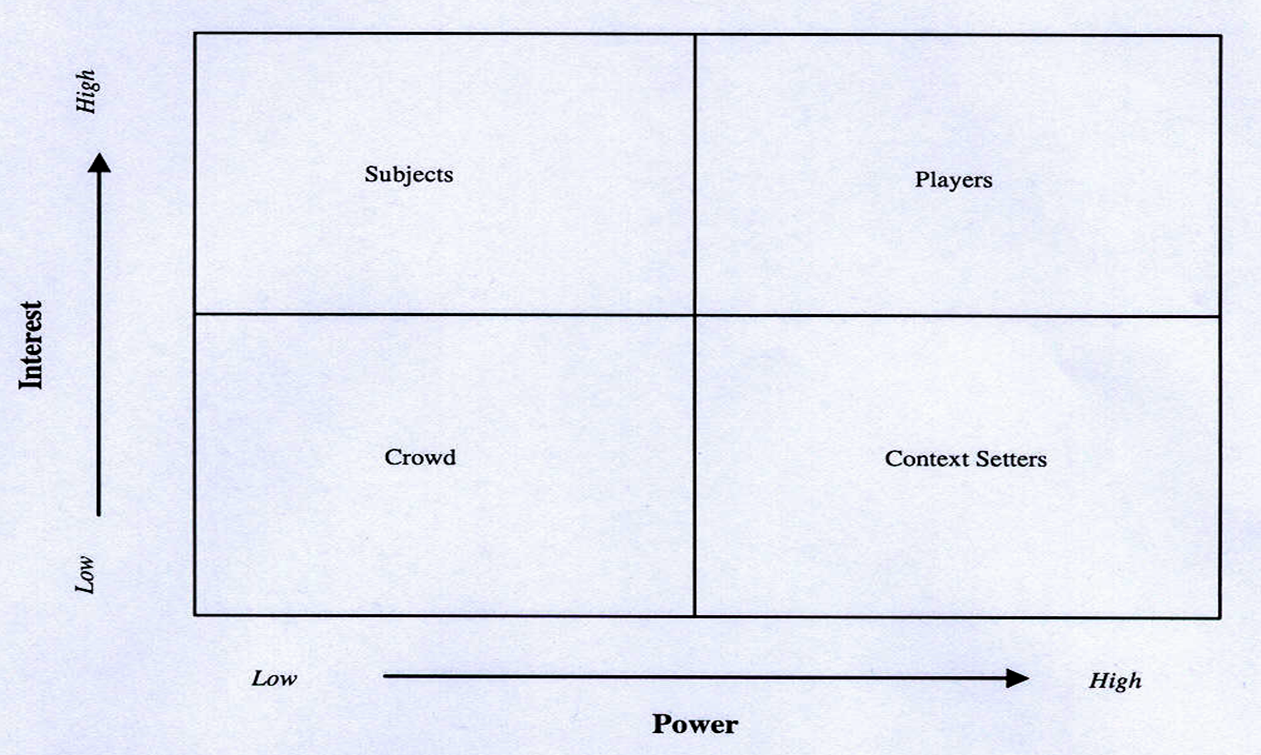
- Identify a broad range of potentially interested actors for the realisation phase. For example, citizens living near the project may have been difficult to mobilise in early, more abstract phases but they will likely be interested now.
- Group and cluster actors, for example:
- Position actors in grids, diagrams, tables (see the power versus interest grid)
- Design a strategy for actor involvement
- Take into account your client’s resources
- Take into account actors’ resources
In a stakeholder involvement strategy, it is advisable to have an open attitude to all stakeholders (i.e., for legitimacy it is unwise to try and lock stakeholders out); however, it is not necessary to actively involve all stakeholders. Power and interest are two main factors with which the most important stakeholders can be selected. Power (or influence) refers to the resources that actors have with which they can influence the decision on a BwN project: financial resources, land ownership, legal decision making power (e.g. on a permit), etc. Interest refers to the potential impact a BwN project can have on the activities and livelihoods of actors. Questions to ask about these two factors are:
- Power: Who can contribute? Who is needed? Who can frustrate/delay?
- Interest (‘imperative’): Who has an interest in, or is affected by, the problem and/or in possible solutions?
Typically, there will be actors who have both power and a high interest; and these are the ones that absolutely need to be involved (‘Players’). In most cases, it won’t be hard to convince them. There are also actors without power, but with a high interest, for example, individual citizens living near a project (‘Subjects’). And there will be actors who have power, but a low interest; for example, a government seated in a distant location (‘Context setters’). Including these two categories will take an extra effort; but excluding them will be a risk for the project. For a conscious assessment who to involve actively, actors can be positioned on interest/ power gradients ore more simply an interest versus power grid (see figure). Thus four categories are created for which generally the course of action is:
- Subjects: keep informed (local citizens, companies)
- Players: get involved (local governments, land owners)
- Context setters: keep satisfied (EU)
- Crowd: passive access to information (national public, journalists)
Organising an effective process of actor involvement is not easy. This is illustrated by the fact that a rather cynical description of citizen participation, the famous Ladder of Participation by Arnstein, from 1969 is often still valid today.
Even though stakeholder participation is still difficult in practice, many methods for public participation have been developed and tried. Some useful resources and overviews can be found in the references section.
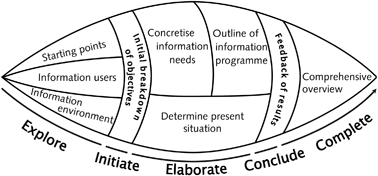
Stakeholder involvement does not lead to an ever expanding list of people who want to be involved in the decision making. Instead, it generally has the shape of a rugby ball: first the number of parties involved is only small, in the next phases it expands and towards the end of decision making it converges again to a small group of organisations who take the final decisions and provide the funding. The rugby ball model can be used to convince people who prefer to involve as little stakeholders as possible (out of fear that no decision can be made at all), to widen the scope.
Practical applications – examples
Due to the fact that innovative procurement and contracting is still nascent the examples given below are of a descriptive nature. Each example includes a link towards documents that include analysis of the case or guidance for handling of similar cases.
Case Melbourne Channel Deepening Project (AUS)
The port of Melbourne is a city port in Melbourne, in the state of Victoria, Australia. The Port of Melbourne is the largest cargo port in Australia. The Melbourne Channel Deepening Project has been initiated by the Department of Infrastructure of the Victorian government, to allow larger ships to enter the Port of Melbourne. Without deepening the port would have become the shallowest port in Australia, as the ports of Adelaide, Sydney and Perth have already upgraded their entrance channels. The port could thereby lose its strong position of being a main node in the network of maritime shipping.
The project is located in Port Phillip Bay, a large but shallow bay, connected with the Bass Strait through a small entrance. Through this entrance runs a deep (80 m) canyon, the remains of the former Yarra river bed. The city of Melbourne has spread around the bay. Due to this position the project is subject to engineering, environmental and social concerns. Deepening the bay’s entrance had previously been done by destroying the rocky sides and pinnacles of the canyon using dynamite. Due to the environmental implications of this practice, this was not considered an appropriate method. A new technique that is able to remove hard rocks while dealing with strong currents had to be developed during the project development. Another open question at the start of the project was how to deal with deposition of dredged material, and especially the contaminated material from the Yarra River. The proposed project plan also had to deal with ecological concerns, such as invasive species, coastal erosion, dredging plumes, the ecosystem in the canyon, and the health of the two penguin populations. The high human population around the bay also asks for considerations as the bay is heavily used as recreation area and as means for a living. Users of the bay, such as divers, boaters, commercial- and recreational fisherman are all concerned that their livelihood will be destroyed due to the dredging program. All these concerns have to be integrated in the project planning and design.
The Melbourne Channel Deepening project is not a pure example Building with Nature case. However, it addresses some design- and governance characteristics that can be used to understand enabling and constraining conditions for Building with Nature projects. Firstly, the Port of Melbourne Corporation entered into a ‘partnership’ with Boskalis. This partnership, that was based on a ‘no blame’ agreement, allowed for an integration of planning and construction considerations. Secondly, an ecosystem approach for the environmental risk and impact management was adopted. This also gave sustainability and environmental safe design principles priority, leading to a situation in which design parameters and engineering solutions became subordinate to environmental risks. A third characteristic is the switch from a ‘closed’ public community communications strategy towards an ‘open’ approach in which community representatives are briefed and open information meetings were held in different places along the bay.
The case study Melbourne port extension addressed the applied project arrangements.
The observations and lessons are included as chapter 3 in the report Infrastructure Planning and Delivery: Best practices and Case Studies (Commonwealth of Australia, Department of Infrastructure and Transport, 2010).
The report can be downloaded
Case Maasvlakte 2, Port of Rotterdam (NL)
The Maasvlakte 2 (MV2) expansion project of the Port of Rotterdam, comprises of a land reclamation project. This project has been initiated by the Port of Rotterdam and the Dutch government to cope with future space shortages of the port. The terms of reference were set by a societal discussion on usefulness and necessity. A conclusion hereof, besides requirements on the size and possible lay-out of the extension, was that the extension of the port should coincide with the creation of additional nature, recreational area and liveability improvements in the broader Rotterdam area (see figure 1). The further development of the project design was taken up by the then privatised port authority by the definition of ‘functional requirements’ that are based on the Terms of Reference, Dutch and EU regulations. Based on these requirements the constructors developed an engineering design. After awarding the contract, the constructors and the port authority aligned to optimise the engineering design. Of interest in this situation is that the port authority, as private entity, was able to discuss both the engineering design with the constructors, as well as the environmental permit requirements with the authorities.
Although not specific tailored towards the Maasvlakte 2 the European PPP Expertise Centre issued relevant guidance with regard to preparing and handling PPP cases such as the Maasvlakte 2 extension case.
Case Grensmaas, River Refurbishment (NL)
This case description gives an example of an innovative realisation arrangement, the Consortium Grensmaas .
The Grensmaas is a part of the Meuse River that forms the border between The Netherlands and Belgium. In this area, several problems led to decades of debate and failed policy making (Warner, 2016):
- As a national policy, private companies got concessions to exploit the gravel in the Meuse River in order to fulfil the national needs for construction materials; however the Province of Limburg and its citizens opposed this because the quarrying left them with many ugly holes in the landscape;
- Gravel transport caused noise and dust, while quarrying vibrations caused damage to houses;
- Chances of winter floods are increasing. Unprotected villages along this stretch of river suffered from flooding in 1993 and in 1995.
Around 2005 the solution was found in the creation of a Consortium Grensmaas in which 14 private companies participated (e.g. Van den Biggelaar, Boskalis & Van Oord; L’Ortye, Geo-control), and the NGO Natuurmonumenten. This consortium was complemented with an organisation ‘RWS Maaswerken’ in which three governments cooperated: the Ministries of Infrastructure and Nature, and the Province of Limburg.
Initiation and realisation by Grensmaas Consortium.
The consortium and the governments signed a contract in 2005 for the run time of 2005-2022. For the local government and the citizens the advantages were that the gravel exploitation was not done in deep pits anymore, but in a more horizontal and landscaping manner that would lead to more water safety and an interesting nature area. Another advantage was that there was now a date, 2022, after which the gravel exploitation in their province would finally end. For the consortium the advantages were that they could keep the concessions that they had for the gravel exploitation, and that they could figure out for themselves how to realise the profit, as long as the end result was according to the agreed landscape plan. The NGO Natuurmonumenten was involved to manage the landscape once it was delivered.
Actual exploitation started in 2008 near the village of Itteren. In 2009 there was agreement on the nature management plan Natura 2000 Grensmaas. The end result will be an area with 1250 hectares of new nature and 479 hectares of existing nature. Extensive recreation will be made possible to enhance the support of the inhabitants.
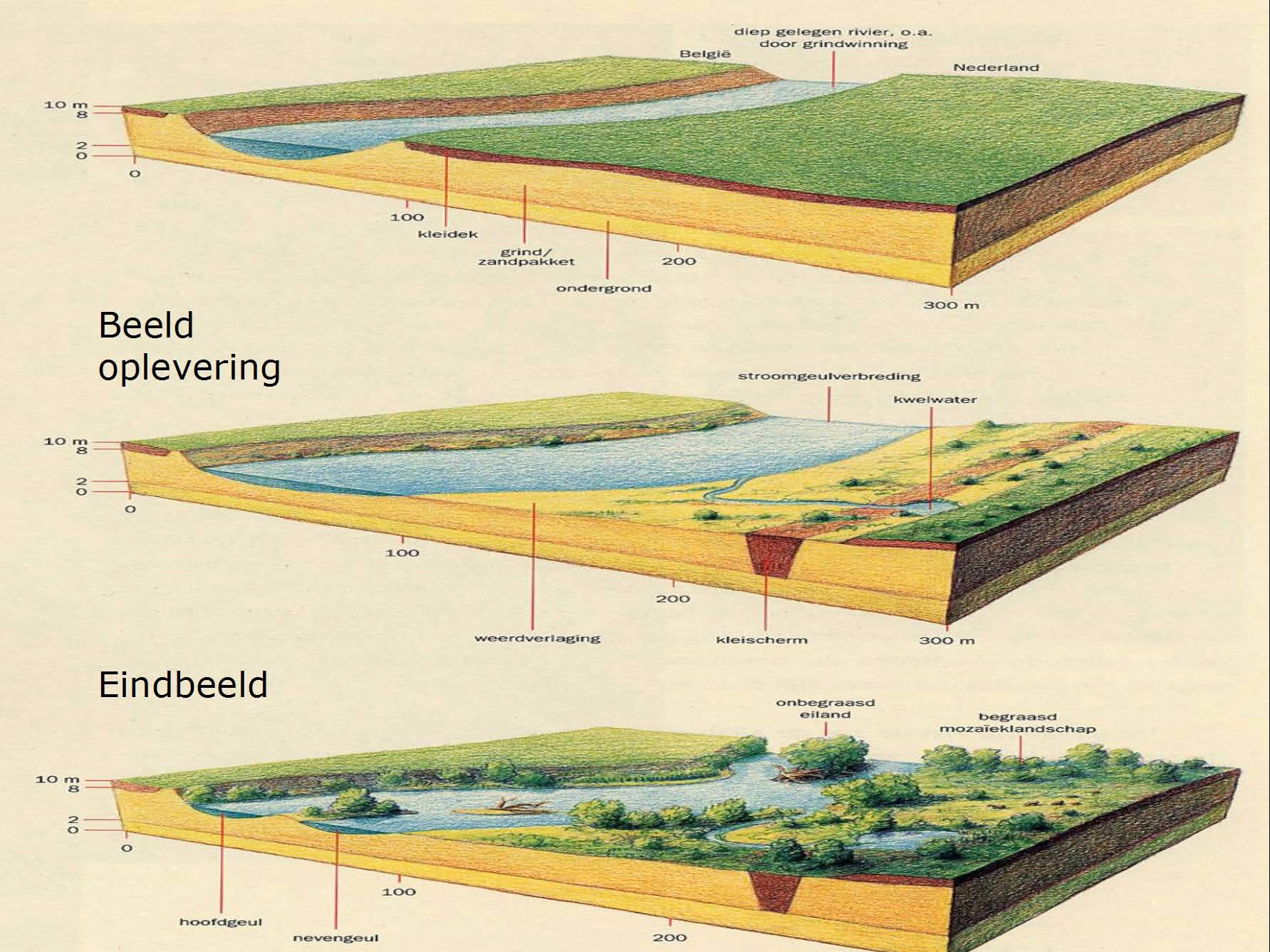
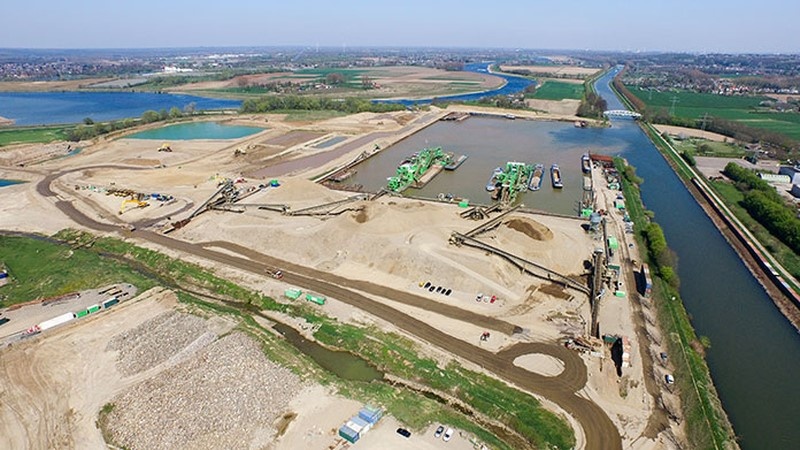
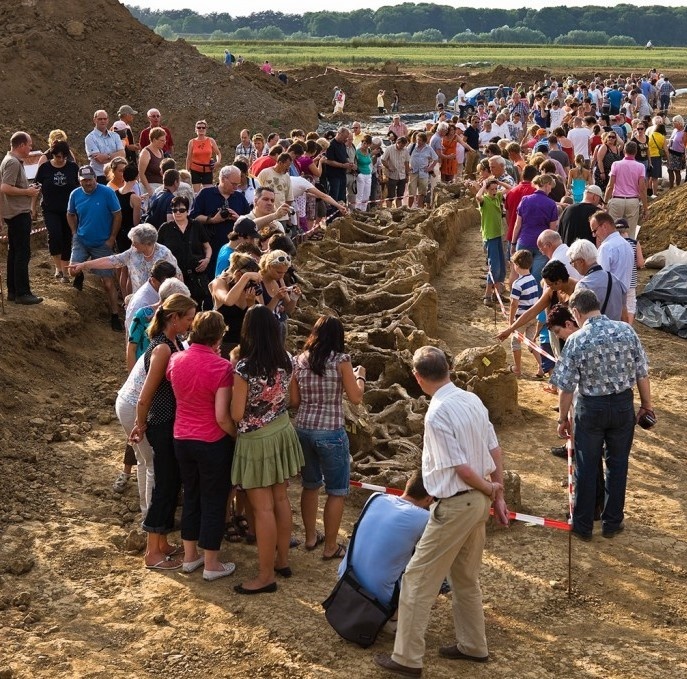
In 2012 a problem arose: because of the economic crisis, the market for gravel temporarily collapsed, which was a severe problem for the private companies. This was a test for the strength of the arrangement. The government stepped in with a temporary loan and a license for temporary storage of the gravel. The companies contributed by taking one of their expensive graveling machines out of business.
The overall results at the end of 2017 can be seen as:
- Locations Borgharen and Geulle aan de Maas are finished and have been handed over to Natuurmonumenten.
- 1114 hectares of nature were realised (92 %).
- The prognosis of the final budget needed is € 139,7 million which is € 10,4 million below the available budget of € 150 million.
- The end date may have to be postponed to 2023.
Figure: the Grensmaas landscape before the project started; the landscape right after finishing the project; and the final landscape after a number of years of nature management.
Communication by the Grensmaas Consortium
This Grensmaas Consortium faced another challenge prior to the economic crisis. After just a few years, the citizens of Limburg turned against the project, complaining that they weren’t getting the interesting landscape that was promised. ‘We are getting stagnant water instead of a gravel river (Dorpsraad Itteren, 2010). The consortium not only tried to respond in a serious way to these complaints, they also started to communicate actively about positive developments in the project.
In 2010, they had discovered a historic grave of war horses from the Battle of Maastricht in 1794. Pictures were sent to the local press and citizens were invited to come and have a look. The remains were excavated by archaeologists and the horses got a permanent monument elsewhere.
In 2011, a mammoth’s tooth was found, which was also reported by the local press. From 2012 onwards, regular newsletters for the local citizens were issued by the consortium (eight issues in 2012, five in 2013, two in 2014, and ten in 2015). A website informs everyone who is interested (http://www.grensmaas.nl/). The summit in the courting of the local citizens was the Grensmaas opera in May 2016. A choreography was written for excavation machines and a large audience enjoyed the show. By that time, the negative publicity had ceased to exist.
References
Literature
- Arnstein, Sherry R., 1969. A Ladder of Citizen Participation, Journal of the American Planning Association, Vol. 35, No. 4, July 1969, pp. 216-224
- Bradford,S.,Siebinga, M., 2009; Communicating about dredging in a precious environment: Port of Melbourne Channel Deepening Project – IADC Terra et Aqua, september 2009
- Bundgaard, K., Klazinga, D., Visser, M., 2011;Traditional procurement methods are broken: can early contractor involvement be the cure? – IADC Terra et Aqua, September 2011
- Commonwealth of Australia, Department of Infrastructure and Transport. 2010. Infrastructure Planning and Delivery: Best practices and Case Studies.
- Eden, C. and Ackermann, F. 1998 Making Strategy: The Journey of Strategic Management, London: Sage Publications.
- Enserink, B., Hermans, L., Kwakkel, J., Thissen, W., 2010 Policy Analysis of Multi-Actor Systems. Boom Lemma Uitgevers, Amsterdam
- Ham, H. van, Koppenjan, J., 2002. Publiek-private samenwerking bij transportinfrastructuur; wenkend of wijkend perspectief, Lemma, Utrecht, 2002.
- Havekes, H., Hofstra, M., Kerk, A. van der,, Teeuwen, B., Cleef, R.van, Oosterloo, K., 2016. Building blocks for good water governance. Dutch Water Governance Centre (WGC), The Hague. https://www.uvw.nl/wp-content/uploads/2017/11/Building-blocks-for-good-water-governance-2016.pdf
- Koppenjan, J.F.M., 2015. Public–Private Partnerships for green infrastructures. Tensions and challenges, Current Opinion in Environmental Sustainability 2015, 12:30–34
- Koppenjan, J.F.M., Enserink, B., 2009. Public–Private Partnerships in Urban Infrastructures: Reconciling Private Sector Participation and Sustainability. Public Administration Review 69 (2):284–96. doi:10.1111/j.1540-6210.2008.01974.x.
- Reynaers, A-M., 2015. Public Water in Private Hands: A Case Study on the Safeguarding of Public Values in the First DBFMO in the Dutch Water Sector. International Journal of Water Governance-2 (2015) 1–16 1, DOI: 10.7564/14-IJWG48
- Warner, J.F., 2016. Of River Linkage and Issue Linkage: Transboundary Conflict and Cooperation on the River Meuse, Globalizations, DOI: 10.1080/14747731.2015.1136786
Internet
Some further reading on stakeholder engagement methods:
- An overview of stakeholder participation methods
- Communities of Practice and other methods for user engagement
- Website of the US EPA
- A report from the Global Water Partnership
Some further reading on PPP in practice:

